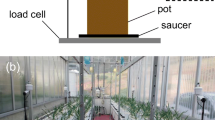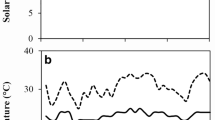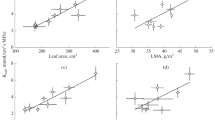Abstract
The effects of low root zone temperatures (RZT) on nutrient demand for growth and the capacity for nutrient acquisition were compared in maize and wheat growing in nutrient solution. To differentiate between direct temperature effects on nutrient uptake and indirect effects via an altered ratio of shoot to root growth, the plants were grown with their shoot base including apical shoot meristem either within the root zone (low SB), i.e. at RZT (12°, 16°, or 20°C) or, above the root zone (high SB), i.e. at uniformly high air temperature (20°/16° day/night).
At low SB, suboptimal RZT reduced shoot growth more than root growth in wheat, whereas the opposite was true in maize. However, in both species the shoot growth rate per unit weight of roots, which was taken as parameter for the shoot demand for mineral nutrients per unit of roots, decreased at low RZT. Accordingly, the concentrations of potassium (K) and phosphorus (P) remained constant or even increased at low RZT despite reduced uptake rates.
At high SB, shoot growth at low RZT in both species was higher than at low SB, whereas root growth was not increased. At high SB, the shoot demand per unit of roots was similar for all RZT in wheat, but increased with decreasing RZT in maize. Uptake rates of K at high SB and low RZT adapted to shoot demand within four days, and were even higher in maize than in wheat. Uptake rates of P adapted more slowly to shoot demand in both species, resulting in reduced concentrations of P in the shoot, particularly in maize.
In conclusion, the two species did not markedly differ in their physiological capacity for uptake of K and P at low RZT. However, maize had a lower ability than wheat to adapt morphologically to suboptimal RZT by increasing biomass allocation towards the roots. This may cause a greater susceptibility of maize to nutrient deficiency, particularly if the temperatures around the shoot base are high and uptake is limited by nutrient transport processes in the soil towards the roots.
Similar content being viewed by others
References
Atkin R K, Barton G E and Robinson D K 1973 Effect of root growing temperature on growth substances in xylem exudate ofZea mays. J. Exp. Bot. 24, 475–487.
BassiriRad H, Radin J W and Matsuda K 1991 Temperature-dependent water and ion transport properties of barley and sorghum roots. Plant Physiol. 97, 426–432.
Bravo F P and Uribe E G 1981 Temperature dependence of the concentration kinetics of absorption of phosphate and potassium in corn roots. Plant Physiol. 67, 815–819.
Buhse J 1992 Wirkung der Wurzelraumtemperatur auf das Phosphataneignungsvermögen von Pflanzen und die Phosphatverfügbarkeit im Boden. Doctoral Thesis, Georg-August-Universität Göttingen.
Clarkson D T 1976 The influence of temperature on the exudation of xylem sap from detached root systems of rye (Secale cereale) and barley (Hordeum vulgare). Planta 132, 297–304.
Clarkson D T and Deane-Drummond C E 1983 Thermal adaptation of nitrate transport and assimilation in roots?In Nitrogen as an Ecological Factor. Eds. J A Lee, S McNeil and I H Rorison. pp 211–224. Blackwell Scientific Publications, Oxford.
Cogliatti D M and Clarkson D T 1983 Physiological changes in, and phosphate uptake by potato plants during development of and recovery from phosphate deficiency. Physiol. Plant. 58, 287–294.
Dale J E, Stacciarini Seraphin E and Sattin M 1990 The effects of root cooling on leaf growth.In Importance of Root to Shoot Communication in the Responses to Environmental Stress. Eds. W J Davies and B Jeffcoat. pp 149–161. British Society for Plant Growth Regulation, Monograph 21.
Deane-Drummond C E and Glass A D M 1983 Compensating changes in ion fluxes into barley (Hordeum vulgare L. cv. Betzes) seedlings in response to differential root/shoot growth temperature. J. Exp. Bot. 34, 1711–1719.
Drew M C, Saker L R, Barber S A and Jenkins W 1984 Changes in the kinetics of phosphate and potassium absorption in nutrient-deficient barley roots measured by a solution-depletion technique. Planta 160, 490–499.
Engels C and Marschner H 1990 Effect of sub-optimal root zone temperature at varied nutrient supply and shoot meristem temperature on growth and nutrient concentrations in maize seedlings (Zea mays L.). Plant and Soil 126, 215–225.
Engels C and Marschner H 1992 Root to shoot translocation of macronutrients in relation to shoot demand in maize (Zea mays L.) grown at different root zone temperatures. Z. Pflanzenernaehr. Bodenkd. 155, 121–128.
Ernst M, Römheld V and Marschner H 1989 Estimation of phosphorus uptake capacity by different zones of the primary root of soil-grown maize (Zea mays L.). Z. Pflanzenernaehr. Bodenkd. 152, 21–25.
Fusseder A 1987 The longevity and activity of the primary root of maize. Plant and Soil 101, 257–265.
Gericke S and Kurmies B 1952 Die colorimetrische Phosphorsäurebestimmung mit Ammonium-Vanadat-Molybdat und ihre Anwendung in der Pflanzenanalyse. Z. Pflanzenernaehr. Dueng. Bodenkd. 59, 235–247.
Grobbelaar W P 1963 Responses of young maize plants to root temperatures. Med. van de Landbouw Hogeschool te Wageningen Nederl. 63, 1–71.
Jungk A and Claassen N 1989 Availability in soil and acquisition by plants as the basis of phosphorus and potassium supply to plants. Z. Pflanzenernaehr. Bodenkd. 152, 151–157.
Lascaris D and Deacon J W 1991 Comparison of methods to assess senescence of the cortex of wheat and tomato roots. Soil Biol. Biochem. 23, 979–986.
Lawlor D W, Boyle F A, Kendall A C and Keys A J 1987 Nitrate nutrition and temperature effects in wheat: Soluble components of leaves and carbon fluxes to amino acids and sucrose. J. Exp. Bot. 38, 1091–1103.
Lee R B 1982 Selectivity and kinetics of ion uptake by barley plants following nutrient deficiency. Ann. Bot. 50, 429–449.
Lefebvre D D and Glass A D M 1982 Regulation of phosphate influx in barley roots: Effects of phosphate deprivation and reduction of influx with provision of orthophosphate. Physiol. Plant. 54, 199–206.
Macduff J H, Hopper M J, Wild A and Trim F E 1987 Comparison of the effects of root temperature on nitrate and ammonium nutrition of oil seed rape (Brassica napus L.) in flowing solution culture. I. Growth and uptake of nitrogen. J. Exp. Bot. 38, 1104–1120.
Mackay A D and Barber S A 1984 Soil temperature effects on root growth and phosphorus uptake by corn. Soil Sci. Soc. Am. J. 48, 813–823.
Pritchard J, Barlow P W, Adam J S and Tomos A D 1990 Biophysics of the inhibition of the growth of maize roots by lowered temperature. Plant Physiol. 93, 220–230.
Setter T L and Greenway H 1988 Growth reductions of rice at low root temperatures: Decreases in nutrient uptake and development of chlorosis. J. Exp. Bot. 39, 811–829.
Thomas A, Tomos A D, Stoddart J L, Thomas H and Pollock C J 1989 Cell expansion rate, temperature and turgor pressure in growing leaves ofLolium temulentum L. New Phytol. 112, 1–5.
Walker J M 1969 One-degree increments in soil temperatures affect maize seedling behavior. Soil Sci. Soc. Am. Proc. 33, 729–736.
White P J, Clarkson D T and Earnshaw M J 1987 Acclimation of potassium influx in rye (Secale cereale) to low root temperatures. Planta 171, 377–385.
White P J, Cooper H D, Clarkson D T, Earnshaw M J and Loughman B C 1991 Effects of low temperature on growth and nutrient accumulation in rye (Secale cereale) and wheat (Triticum aestivum). Ann. Bot. 67, 23–31.
White P J, Cooper H D, Earnshaw M J and Clarkson D T 1990 Effects of low temperature on the development and morphology of rye (Secale cereale) and wheat (Triticum aestivum). Ann. Bot. 66, 559–566.
Williams R F 1948 The effects of phosphorus supply on the rates of intake of phosphorus and nitrogen and upon certain aspects of phosphorus metabolism in graminaceous plants. Austr. J. Sci. Res. B1, 333–361.
Author information
Authors and Affiliations
Rights and permissions
About this article
Cite this article
Engels, C. Differences between maize and wheat in growth-related nutrient demand and uptake of potassium and phosphorus at suboptimal root zone temperatures. Plant Soil 150, 129–138 (1993). https://doi.org/10.1007/BF00779183
Received:
Accepted:
Issue Date:
DOI: https://doi.org/10.1007/BF00779183




